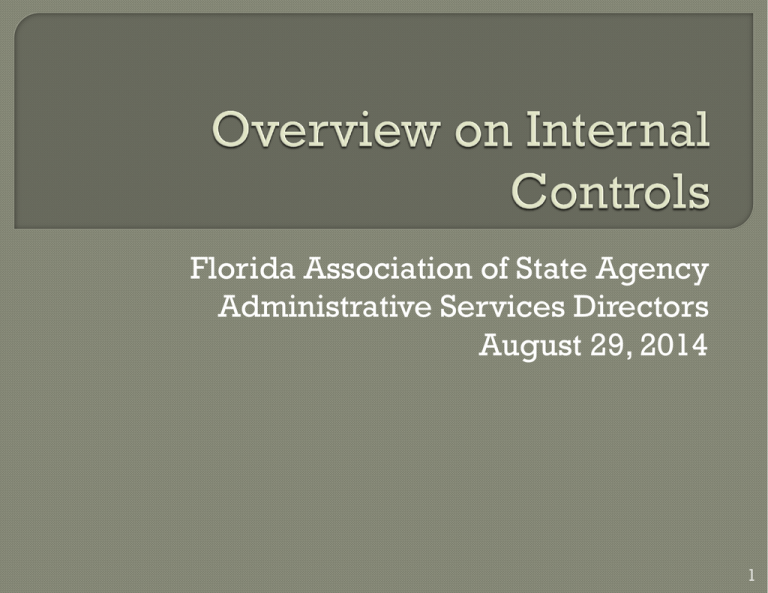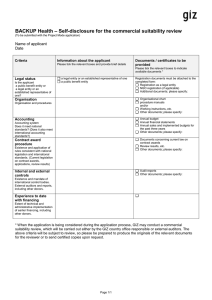DFS - Internal Control Presentation
advertisement

Florida Association of State Agency Administrative Services Directors August 29, 2014 1 ‘Internal control gets us where we want to go, without surprises along the way. Internal control is everyone’s responsibility … Internal control is me.’ - from Cargill Corporation’s Internal Control Statement ‘Control ... Support(s) people in the achievement of the organization’s objectives … Control is what makes an organization reliable in achieving its objectives.’ - from Guidance on Control, The Canadian Institute of Chartered Accountants 2 Myths “Internal control is a money (financial resources) thing. We do what the CFO tells us to do.” “Internal controls are essentially negative, like a list of ‘thou shall nots.’” “Internal control starts with a strong set of policies and procedures.” and FACTS - Although the financial aspect of control is very important, observable, and measureable; internal control effects every aspect of the organization’s activities, such as suitable enforcement of regulations, health and safety, efficient use of resources, and our reputation. 1. Internal controls helps the right thing happen the first time. 2. Repeat step 1 Helps people avoid making poor decisions. Reduces the need for error correction. - Control environment comes first. 3 Internal control is defined as: Internal control is a process, effected by an entity's board of directors, management, and other personnel, designed to provide reasonable assurance regarding the achievement of objectives relating to operations, reporting, and compliance. This definition emphasizes that internal control is: • Geared to the achievement of objectives in one or more separate but overlapping • • • • categories - operations, reporting, and compliance A process consisting of ongoing tasks and activities - a means to an end, not an end in itself Effected by people - not merely about policy and procedure manuals, systems, and forms, but about people and the actions they take at every level of an organization to effect internal control Able to provide reasonable assurance - but not absolute assurance, to an entity's senior management and board of directors Adaptable to the entity structure - flexible in application for the entire entity or for a particular subsidiary, division, operating unit, or business process. 4 A common objective is to efficiently safeguard assets with limited resources When you are unable to assign the tasks of receiving assets separately from those of asset custodian, create additional controls to reduce risks to an acceptable level. Examples could include: Ensure procedures are well documented, understood, and followed: Leave the quantity to be received blank on the receiving report. The receiver/custodian states the number of items received and forwards the report to the person who approves the invoice. The invoice is compared to the number ordered from the PO and the number received; Secure the assets so only the custodian has access to them; Conduct frequent (small) inventories of the assets the custodian has under their control. Have the supplier ship directly to end users as needed instead of to the custodian. Use directive, preventive, detective, and mitigating controls in combination with one another. 5 The Internal Control Framework sets out three categories of objectives, which allows organizations to focus on separate aspects of internal control. Operations Objectives - includes operational and financial performance goals, and safeguarding assets against loss through • Effectiveness and • Efficiency of the entity’s operations. Reporting Objectives - encompassing reliability, timeliness, transparency, or other terms as set forth by regulators, standard setters, or the entity’s policies for • internal financial and non-financial reporting • external financial reporting and • external non-financial reporting. Compliance Objectives - these pertain to adherence to laws and regulations to which the entity is subject. 6 Supporting the organization in its efforts to achieve objectives are five components of internal control: • Control Environment • Risk Assessment • Control Activities • Information and Communication • Monitoring Activities These components are relevant to the entire entity and to its organization, its subsidiaries, divisions, or any of its individual operating units, functions, or other subsets of the entity. 7 Depicted in a cube, the relationships between categories of internal control objectives, components of internal control, and the entity structure may be viewed as: Vertical columns providing width are the three categories of objectives Horizontal rows providing height are the five components of internal control Vertical bands or layers providing depth represent the entity structure, beginning at the principal level and moving through the organization structure to the lowest level operating unit. 8 Written for Government • Leverages the COSO Framework • Uses government terms May be an acceptable framework for internal control for state and local government use under OMB Uniform Guidance for Federal Awards In addition to the 17 principles included in the COSO Internal Control framework, the Green Book extends the principles with attributes • In general, all components, principles, and relevant attributes are required for an effective internal control system • Management needs to document the circumstances if a principle or attribute is not relevant; to include the rationale of how in its absence, the associated component can be designed, implemented, and operated effectively. * Comptroller General of the Untied States, Standards for Internal Control in the Federal Government, 2013 Exposure Draft 9 Attributes contribute to the design, implementation, and effectiveness of principles that make up internal control For example Control Environment Component • Principle 4: Demonstrate Commitment to Competence Attributes: o Establish expectation of competence o Attract, develop, and retain individuals, and o Plan and prepare for succession The attributes are presented as part of management’s responsibilities o Management should establish expectations of competence throughout the organization o Management should attract, develop, and retain competent personnel, and o Management should define succession and contingency plans for key roles in the organization. 10 The Green Book defines an internal control system as “a continuous built-in component of operations, effected by people, that provides reasonable assurance, not absolute assurance, that an organization’s objectives will be achieved.” An effective internal control system requires that each of the five components, 17 principles, and relevant attributes are: • Effectively designed, implemented, and operating • Operating together in an integrated manner It is management’s responsibility to evaluate the effect of deficiencies on the internal control system A component is not likely to be effective if the related principles and attributes are not effective. 11 The control environment is the set of standards, processes, and structures that provide the basis for carrying out internal control across the organization. The board of directors and senior management establish the tone at the top regarding the importance of internal control and expected standards of conduct. Principle 1: Demonstrates Commitment to Integrity and Ethical Values Principle 2: Exercises Oversight Responsibility Principle 3: Establishes Structure, Authority, and Responsibility Principle 4: Demonstrates Commitment to Competence Principle 5: Enforces Accountability 12 Risk assessment involves a dynamic and iterative process for identifying and analyzing risks to achieving the entity's objectives, forming a basis for determining how risks should be managed. Management considers possible changes in the external environment and within its own business model that may impede its ability to achieve its objectives. Principle 6: Specifies Suitable Objectives Principle 7: Identifies and Analyzes Risk Principle 8: Assesses Fraud Risk Principle 9: Identifies and Analyzes Significant Change 13 Control activities are the actions established by policies and procedures to help ensure that management directives to mitigate risks to the achievement of objectives are carried out. Control activities are performed at all levels of the entity and at various stages within business processes, and over the technology environment. Principle 10: Selects and Develops Control Activities Principle 11: Selects and Develops General Controls over Technology Principle 12: Deploys through Policies and Procedures 14 Information is necessary for the entity to carry out internal control responsibilities in support of achievement of its objectives. Communication occurs both internally and externally and provides the organization with the information needed to carry out day-to-day controls. Communication enables personnel to understand internal control responsibilities and their importance to the achievement of objectives. Principle 13: Uses Relevant Information Principle 14: Communicates Internally Principle 15: Communicates Externally 15 Ongoing evaluations, separate evaluations, or some combination of the two are used to ascertain whether each of the five components of internal control, including controls to effect the principles within each component, is present and functioning. Findings are evaluated and deficiencies are communicated in a timely manner, with serious matters reported to senior management and to the board. Principle 16: Conducts Ongoing and/or Separate Evaluations Principle 17: Evaluates and Communicates Deficiencies 16 • Financial Reporting Management Representation letter(s) assuring agency compliance for financial reporting • Florida Statutes • Federal Regulations GAO Standards for Internal Control in the Federal Government (Green Book) (exposure draft) GAO Government Auditing Standards (Yellow Book) OMB Uniform Guidance for Federal Awards Federal Sentencing Guidelines 17 Florida Statutes provide that agencies establish and maintain internal controls in • Section 215.86 Management systems and controls, and • Section 20.55 Agency inspectors general, subsection (5). Federal Regulations provide that internal controls be established and maintained in the Uniform Administrative Requirements, Cost Principles, and Audit Requirements for Federal Awards, dated Dec. 26, 2013. 2 CFR, part 200.303. The Federal Regulation anticipates that the internal controls comply with guidance in the • GAO Standards for Internal Control in the Federal Government, and • COSO Internal Control Integrated Framework. 18 Financial statement audits performed in accordance with generally accepted governmental auditing standards also includes reports on internal controls over financial reporting and on compliance with provisions of laws, regulations, contracts, and grant agreements that have a material effect on the financial statements. (GAO Yellow Book) The Sarbanes-Oxley Act of 2002, directed the U.S. Sentencing Commission to review and amend, the federal sentencing guidelines to ensure that guidelines applicable to organizations “are sufficient to deter and punish criminal misconduct.” In Chapter 8 – Sentencing for Organizations, factors weighing on the level of punishment includes the extent the organization exercises due diligence and the promotion of an organizational culture that encourages ethical conduct and a commitment to compliance with the law. This includes establishing standards of conduct and internal controls that are reasonably capable of reducing the likelihood of criminal conduct. 19 In conformance with Auditing Standards1, The Chief Financial Officer (CFO) is required to make specific written representations to the Auditor General that management has fulfilled its responsibility in the preparation of the Consolidated Annual Financial Report (CAFR) financial statements and administration and reporting of Federal awards. The Agency Representation Letter is used as a means for the agency, in turn, to certify to the CFO that they are incompliance with all of the applicable information provided within the CFO’s representations. The applicable time period covered by the letter is from the beginning of the period that financial information is provided to the CFO through the CAFR issuance date. It should be noted that management’s responsibility for internal controls are the first two topics in the agency letter and the second topic in the Federal awards representation letter. 20 A Closing Thought When someone tells you they already have internal controls, as in “We have Segregation of Duties”; put this statement into context. Segregation of Duties is one example of four types of Control Activity categories (Preventive, Directive, Detective, and Mitigating or Compensating.) Control Activities is one of the five internal control Components. Put differently, with just using Segregation of Duties, you’re let’s say 4% to completion. Components Categories Control Environment Risk Assessment Control Activities Directive Control Activities Detective Control Activities Mitigating Control Activities Preventive Control Activities Preventive Control Activities Preventive Control Activities Preventive Information & Communication Monitoring Activities Examples of categories Segregation of Duties Physical Safeguards Authorizations Passwords Illustrative Weighting 20 18 6 5 5 4 2 2 2 18 18 100 21




